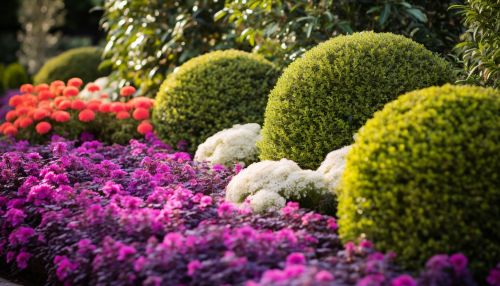Shrubs
Introduction
Shrubs, also known as bushes, are small- to medium-sized perennial plants that are distinguished from trees by their multiple stems and shorter height, typically less than 6 m (20 ft). They are a key component of the Earth's ecosystems, providing habitat, food, and protection for a multitude of organisms.


Classification
Shrubs are classified into two main types: deciduous and evergreen. Deciduous shrubs shed their leaves annually, while evergreen shrubs retain their leaves throughout the year. The classification of shrubs also takes into account the plant's growth habit, leaf structure, and other morphological features.
Morphology
Shrubs exhibit a wide range of morphological characteristics. They typically have a woody stem and multiple branches that arise at or near the base of the plant. The leaves of shrubs can be simple or compound, and their arrangement on the stem can be opposite, alternate, or whorled. The flowers and fruits of shrubs are also diverse, ranging from inconspicuous to showy, and from dry to fleshy.
Ecology
Shrubs play a crucial role in various ecosystems, from forests and grasslands to deserts and tundras. They provide shelter and food for a multitude of organisms, contribute to soil formation and nutrient cycling, and help prevent soil erosion. Some shrubs are pioneer species that colonize disturbed areas and pave the way for the establishment of other plant species.
Cultivation
Shrubs are widely cultivated for their ornamental value, for wildlife habitats, and for their useful products. They are used in landscaping for their aesthetic appeal, for creating privacy screens and hedges, and for their ability to attract birds and butterflies. Some shrubs are also grown for their edible fruits, medicinal properties, and for their wood.
Uses
Beyond their ecological and ornamental uses, shrubs have a wide range of practical applications. Some species provide timber, fiber, or fuel, while others are used in the production of foods, beverages, medicines, dyes, and cosmetics. The cultural significance of shrubs is also considerable, with many species featuring in folklore, religion, and art.
Conservation
While many shrub species are common and widespread, others are rare and endangered. Conservation efforts for shrubs include habitat protection, propagation and reintroduction, and the control of invasive species. The conservation of shrubs is not only important for the preservation of biodiversity, but also for the ecosystem services they provide.
